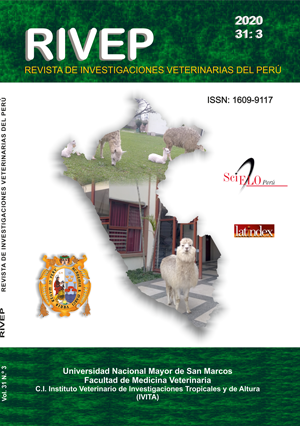Effect of the inclusion of different levels of probiotic on the productive parameters and intestinal morphology in fattening guinea pigs (Cavia porcellus)
DOI:
https://doi.org/10.15381/rivep.v31i3.18735Keywords:
probiotic, productivity, intestinal morphology, guinea pig, PerúAbstract
The aim of this study was to evaluate the effect of increasing levels of probiotic as zinc-bacitracin substitutes in the productive performance and intestinal morphology of fattening guinea pigs. Fifty weaned male guinea pigs were randomly distributed into five treatments consisting of supplementation with 0, 1, 2 and 3 ml of the probiotic "Guinea Pig Biomodulator" and an additional treatment with zinc-bacitracin. Body weight gain, feed intake and feed conversion during 70 days of growth, and intestinal morphology variables: villus length and width, Lieberkühn crypt depth, and villus length/crypt depth ratio were evaluated in the duodenum, jejunum, and ileum. Increasing probiotic levels linearly improved (p=0.008) feed conversion rate but had no effect on the other productivity components. In the intestine, only the length/depth relationship in the ileum was positively affected (p=0.026) by the probiotic. It is concluded that there is no consistent effect of the probiotic on weight gain or on the intestinal morphology of fattening guinea pigs.
Downloads
Downloads
Published
Issue
Section
License
Copyright (c) 2020 Fernando Carcelén C., Felipe San Martín H., Miguel Ara G., Sandra Bezada Q., Ana Asencios M., Ronald Jimenez A., Gilberto Santillán A., Rosa Perales C., Jorge Guevara V.

This work is licensed under a Creative Commons Attribution-NonCommercial-ShareAlike 4.0 International License.
AUTHORS RETAIN THEIR RIGHTS:
a. Authors retain their trade mark rights and patent, and also on any process or procedure described in the article.
b. Authors retain their right to share, copy, distribute, perform and publicly communicate their article (eg, to place their article in an institutional repository or publish it in a book), with an acknowledgment of its initial publication in the Revista de Investigaciones Veterinarias del Perú (RIVEP).
c. Authors retain theirs right to make a subsequent publication of their work, to use the article or any part thereof (eg a compilation of his papers, lecture notes, thesis, or a book), always indicating the source of publication (the originator of the work, journal, volume, number and date).










